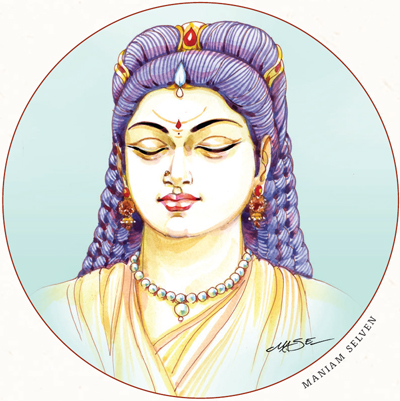
Joy: Happiness, laughter, humor§

Hasya is one of the most pleasant rasas. The word hasya means joy, laughter and humor. Hasya is the joy we see in innocent people. Pure hasya springs up from within for no apparent reason. Children laugh simply because they feel good. During the journey to adulthood, joy is inhibited as carefree children change into serious adults. This is because ego and intellect generate self-consciousness, which prevents one from simply feeling happy. In this way, joy becomes less spontaneous, more restrained by mind.§
Joy is natural and healthy. It aids digestion and rejuvenates the body. It makes us feel light. When the atmosphere is serious, a little humor brightens people’s spirits. However, someone who is feeling sad, afraid or angry is rarely in the mood to laugh. At such times, laughter can be disgusting and unbearable. Introducing humor at the wrong time can lead to conflict and misunderstanding.§
Pure humor is mostly an innocent mind game. But when ego and intellect get involved, malice may slip in, as in political cartoons. Adults may laugh at the cost of others rather than just for the sake of laughter. When humor belittles people or puts them down, it is destructive. Humor then becomes satire or sarcasm (vyangya), which is a sub-rasa of hasya. Sarcasm criticizes others in a harsh way with a veiled message. It invokes laughter but hurts the targeted person and may create problems. The wise well know that the use of humor needs discipline and care. We should not make fun of others to get a laugh; instead we might act to make them laugh at us. Done well, humor can neutralize conflict and contention.§

People need entertainment, and sources of laughter are a main provider. Humor contributes to the amusement of circus acts. Playing a fool, like clowns do, is one of the most effective ways to make people laugh. Some clowns and comedians are true artists at eliciting enjoyment and humor without the bite of satire.§
Master Comedians§
Master comedians hardly need anything to create a funny situation. Charlie Chaplin used pure humor and satire in his repertoire. Mostly he played a tramp who overcame life’s problems with dignity, while also eliciting empathy from his audience; but in the 1940 film The Great Dictator, he “innocently” satirized Adolf Hitler. Buster Keaton, on the other hand, never played a joke on anyone. Rather he made fun at his own expense. He evoked laughter and amazement (adbhut rasa) with his characters’ courageous determination (veer rasa) to overcome apparently impossible physical challenges, always remaining calm (shanti rasa). Mind’s imaginative qualities were responsible for conceiving the death-defying physical feats he performed. But Keaton’s humor was thoughtful and took meaning from the characters he played more than from any specific thing they did.§

Love: Affection, romance, devotion§

SHUTTERSTOCK§
The Sanskrit word shringara means love, romance, decoration, beauty, beautiful, attractive and aesthetic sense. Shringar includes various kinds of love, including romantic love, the love between siblings and love for a pet. Devotional love (bhakti) and parental love (vatsalya) are almost rasas in themselves.§
Songs about the childhood of Krishna and Rama tell us that little Krishna was playful and sometimes naughty, whereas Rama was more serious. By seeing Krishna and Rama as children, we think of God every time we see a child, and that increases our devotional love.§
At the onset of puberty everybody is visited by shringara. It is the predominant rasa during adolescence. Teenagers go through great changes in body chemistry. They want more attention, more love, more care. They feel something is missing. Some feel uneasy; others feel depressed. For the fortunate, loves matures and fills life with affection.§
Shringara basically is emotional and mental, but when we fall in love, our body becomes overwhelmed as well. Humans have no clear mating season as do animals. Sensual feelings may come at any time, and they can be enhanced by hormones, as happens with women just before ovulation.§
Intellect does not play a big role in matters of love. Often in life we ask the intellect to keep quiet and not disturb us. This may cause us to make decisions without sound intellectual understanding. In matters of love this is frequently the case.§
When we see an attractive person and ego does not allow flirtation, then mind can only take small glances. On the other hand, when ego is interested, fantasy feeds the flirtation. Mind can emphasize the beloved’s beauty so much that nobody else in the world looks as beautiful. To create this effect, mind makes many small changes in the perceived appearance of the person. Later, when the effect has faded, mind sees the person more realistically.§
If we see our beloved as an object of desire and the body smell of our dear one excites us, then our love is more physical. On the other hand, when the beauty of our beloved appears divine and his or her eyes intoxicate us, making us forget about ourself, then our love becomes spiritual. Shringara rasa can sustain the feelings of love for many years, even more than a lifetime. In India when partners are profoundly pleased with each other, they may promise to marry again in their next life. If one dies earlier, he or she will postpone taking a new birth so that the two can meet again.§
Love and Other Rasas§
Anger and disgust destroy the body chemistry associated with shringara. In their presence, love vanishes. In contrast, joy and amazement combine well with shringara. They help to create an inspiring atmosphere.§
Sadness has a dual relationship with shringara. Sadness (especially its sense of compassion) and love are combined in bhakti, but otherwise sadness spoils love. For example, if one remains unhappy month after month, his or her partner may get discouraged and abandon the relationship.§
Fear does not induce love, but love induces fear. A little fear is not harmful; it is necessary to prevent becoming a flirt. But it can become too much. Love can make us full of fear. Only people who are crazy in love are fearless. The biggest fear in love is that we will lose our beloved. Even when the beloved is with us and does not intend to leave, we still may fret about being left alone like a motherless baby. Fear may also arise when we think about the welfare of our near-and-dear ones and about our ability to keep them secure and happy.§
Pleasing our partner is not the only priority in life. Though couples don’t have to fight, it is healthy and normal for partners to occasionally have differing opinions. If we avoid speaking the truth for fear of losing our partner—if we suppress our feelings, constantly afraid of expressing our opinion—that fear is more dangerous to the relationship than any difference of viewpoint. In love, sacrifice of ego is necessary. We all know of or may have experienced sacrifices made for the sake of love. Such sacrifices usually grow out of parental love, romantic love or devotional love.§
Devotional Love§
Shringara includes the love for God (bhakti). Love for our partner becomes spiritual when it is directed towards God. Mirabai was a great bhakta poetess who was in love with Krishna. Her still-popular devotional love songs are about her beloved. She longs to be with Him. She is jealous of Krishna’s flute because it is touching His lips and receiving His breath, and she cannot be so near. Her resulting grief illustrates how bhakti combines love and sadness.§

Sadness: Sorrow, heartbreak, sympathy§

SHUTTERSTOCK§
The Sanskrit word karuna means sadness, sorrow, pity, misery and compassion. The compassion element derives from the empathy we feel when others are suffering.§
Small children are rarely sad. They may cry because of hunger, a bee sting or a wet diaper, but that is a distress call rather than sadness. Older children and adolescents get sad when their need for attention and recognition is not fulfilled. Failure or perceived failure triggers sadness. Success relieves sadness, but only briefly. For young adults, sadness retreats when larger goals are met, such as finding one’s partner or a sought-after job.§
Sadness often peaks during mid-life, when people realize their youth is fading. Some may start a new relationship to prove they are still young. Others accept things as they are and seek new meaning by reaching out for rewarding activities, such as helping younger generations.§
A good thing about sadness is that it focuses us on the cause of our sadness. When a family member dies, we visit the crematorium to take their leave. The sadness that we feel centers our mind. When the body is put in the fire, we realize that one day we will die also. Awareness of our mortality creates a certain level of indifference toward worldly pleasures and gratification of the senses. We see that ultimately only a few things in life really matter. Less important things don’t attract us as much. That recognition is non-attachment (vairagya). Such an experience may motivate us to start living on bare necessities, to share more, which makes us better human beings and is a major step towards God. But when we leave the crematorium and pick up our everyday life again, vairagya mostly drops away and we continue living as before.§
Misery can be difficult to comprehend. Some things are really not the way we think they should be. We see people who are doing wrong yet seem to prosper, and others who behave well and have to suffer. Without the concepts of karma and reincarnation, such apparent injustices are difficult to understand and accept.§
Compassion§
Karuna also means compassion for all creatures. That includes all people who ever hurt us. We should not attempt to punish them or even have negative thoughts about them. Rather, we should pray to God to give them proper understanding and kindness.§
In the event that we are forced to defend ourselves, we should oppose our enemies with respect. For example, as my guru noted, when a Hindu rejoices because 20 Muslims died in a Hindu-Muslim riot, such lack of pity is wrong. Unfortunately, many of us are selective with our compassion. We limit it to particular people who are close to us or who are like us.§
Karuna, compassion, is often used as a tool for religious, political and commercial purposes. We may be shown pictures of suffering children to solicit donations, or urged to enter a lottery because some of the money will go to charity. To promote policy, politicians call on our compassion to help certain groups of citizens.§
When it is not purely selfless, karuna has an aspect of give and take, quid pro quo. Most people who help others expect some form of return. Human nature is like that; we tend to operate like businessmen. We may respond to a request for charity in order to save on our income tax. When we help somebody, we feel we should get something in return—if not a return favor, then at least gratitude and respect. True giving has none of this.§
In spiritual life, we should not measure things in terms of profit and loss. If we worship God, it is for our own satisfaction; it does not mean we are doing God a favor and that He should do something in return. It is our human nature to expect rewards for good behavior, but that expectation creates problems for us, because if we get sufficiently frustrated, we may begin to feel that there is no divine justice and lose faith in God.§
Overcoming Sadness§
For most of us, sadness comes and goes, usually in response to outside events. When we feel sad, good people often try to comfort us. They help us overcome our sorrow. Such help is a blessing; but because sad people typically get more attention than those who laugh, some people may act sad to attract attention.§
A change of place, atmosphere or attention can help mitigate sadness, if only temporarily. If a friend enters the room, we may push our sadness aside for a few minutes to see what’s up. When we are on our own again, sadness quickly returns because it is still in our body chemistry. Sometimes a joke can cheer a person up. People of weak constitution, whether due to malnutrition, illness or other causes, naturally are low on enthusiasm and especially prone to sadness. Sometimes music or poetry helps. A little walk in a forest, near a river, lake or mountain may improve our mood. When a person feels sad because of the death of somebody close to them, ego may start searching for someone or something to help. People who are grief-stricken like to be in the company of saints, because saints are calm; they transform sadness into non-attachment.§
Our attitude matters. When our partner dies and we think our suffering will never end, sorrow is prolonged. However, if we have confidence that we will find ways to continue living, suffering will be curtailed. We can engage intellect to start inventorying possibilities for change and relief. As the mind considers each, such exploration leaves less time and energy for sadness.§
We think we are time-bound creatures. We think we take birth and later die with only a small span of life between. In fact, we are eternal consciousness, without beginning or end. Our bodies are clothes that we discard when they become worn. Once bare, we put on a new set. Accordingly, we should identify less with our body and instead consider it a tool that we can use to accomplish the task for which we have taken birth. If we have this attitude towards our physical life and body, we will not be overcome by sadness.§

Anger: Irritation, stress, rage§

SHUTTERSTOCK§
Anger, raudra, resides in everybody. It is the most common rasa, yet the most unwanted. Few there are who are completely anger-free. And many are angry all the time. Anger, like fear (bhayanaka), thrives on insecurity, which is humanity’s basic problem. Anger is principally a reaction to feelings of insecurity triggered by frustration, criticism or threat. Strong persons do not anger quickly, because they inwardly trust themselves to manage challenging situations. Individuals who lack that confidence anger more quickly due to their greater insecurity. They fear they cannot handle difficult situations. As such, anger is a sign of weakness.§
Anger often arises from a hurt ego. It emerges when our talents are not recognized or our expectations are not met. For example, when one person is favored over another, the neglected person may get angry because of feeling humiliated, unappreciated or ignored. If it were up to our minds, we would not stay angry for more than fifteen minutes, because mind is so fluid by nature. But if our ego takes the situation seriously and gets involved, our anger is more prolonged.§
The least harmful form of anger is the one that is expressed when the cause is proximate. It flashes and quickly subsides, as when someone cuts in line at the theater. Anger that endures, festers and turns into resentment is the worst. It lives within us and it grows, causing mental, emotional and physical problems. Long-lasting anger mixed with disgust (vibhatsya) is hate. It causes us to focus on the negative qualities of others and ignore their good qualities.§
One raudra story tells of a person who was cut in a fight. He decided to keep the wound disturbed and not let it heal until he had taken revenge. Similarly, anger can be prolonged and kept alive by letting intellect analyze how we got insulted and by allowing mind to relive the affront. Such stoked anger often develops into a grudge, which is a form of mental illness. Extreme examples of grudges being held are families that continue blood feuds for generations, or entire communities who never forgive injuries and injustices and thus perpetuate conflict.§
Managing Anger§
Anger cannot be completely avoided, but it can be converted and redirected to constructive purpose. It can be used as a source of energy directed to our work, to some other creative enterprise resulting in productive output, or to a piece of art. Anger has fueled people to help the world by fighting injustice. When Gandhi travelled through South Africa, he became enraged when a British official had him thrown off a train. That indignation grew in him, but he directed it toward effective change in law and society. As a consequence, one day the British were thrown out of India.§
Anger boosts the ego; the angrier we are, the more we say “I” and “me,” rather than “you” and “we.” Our intellect gets shut off, and we forget about right and wrong. When we are caught by anger, we may overact, even displaying our outrage like a stage performance. At such moments, it is to our benefit to realize that we have been caught by our emotion and to create a little distance from our feelings. Watching for anger helps us recognize it immediately, so that we can mitigate the potential damage it can cause. To do that, we have to remain awake, be alert, and avoid laziness and dullness, including that caused by substances such as recreational drugs.§
Anger powerfully affects our body chemistry. It creates heat, dryness and acidity. Our breathing becomes fast and shallow and our voice turns loud and harsh. Our body chemistry then affects and feeds our anger, and the cycle intensifies. If we sense we are getting angry, we should check our breathing and slow it down if necessary. We may chew a pod of cardamom, take a walk, drink some water, or wash our face, hands and feet.§
Anger is destructive. When kept inside, repressed, it is self-destructive, slowly consuming us. Outward expressions of anger are common, but in many cases they are unacceptable. For example, when we get angry with our boss, we cannot express that anger freely or we may jeopardize our position. We have to remain respectful. For the moment, we might escape to the rest room and wash our face. If we then get busy with something else, after a few minutes our body chemistry changes, lessening the risk of a hurtful outburst. For the longer term, we should find ways to express the pain or injustice behind the anger in a controlled manner, either to the boss or to some helpful person, such as a therapist or trusted friend.§
When we do have an opportunity to let the offending person know that we have a problem, if that person ignores us and continues the wrongful behavior, we may conclude that the wrongdoer deserves punishment. But we don’t have to deliver the punishment ourself. In due time, somebody will teach that person the needed lesson. That is the law of natural justice: wrongful deeds always earn bad karma. Faith in karma’s natural justice can help people who have been abused as children. Their anger can be cured only if they learn to forgive. This may seem impossible; but with help of good energies from within, support from others and an understanding of karma, it can be done.§
Insecurity makes us feel weak, which triggers fear, which in turn produces anger. We can do several things to prevent or reduce episodes of anger from occurring. We may reduce our intake of sugar and fat, get proper physical exercise, like a daily half-hour walk, and practice nonviolence. We can help others, which reduces their insecurity. These practices increase our own well-being and self-confidence, which is the key to mastering our anger. When we cultivate our inner strength by maintaining such disciplines, we reduce our feelings of insecurity, fear and anger, and we increase our self-confidence and self-esteem. Gaining inner strength gives us power over our anger instead of its having power over us.§

Disgust: Aversion, dissatisfaction, depression§

SHUTTERSTOCK§
The Sanskrit word vibhatsya means disgust, aversion, annoyance and dissatisfaction. The feeling of disgust comes from and causes a body environment that is uncomfortable. As a result, we feel emotionally uncomfortable as well. Disgusted people often use distasteful language; but more often their dissatisfaction and annoyance remain in thought form. Prolonged disgust is self-destructive. Disgust can be caused by others, but we can also feel aversion with ourself. When we loathe and degrade ourself, we undermine our power and obscure our divine nature.§
A common trigger for vibhatsya for many people is not being paid properly for their work. As a result, they have problems sustaining their families. They feel hurt and dissatisfied because their work is not valued. In other circumstances, we just feel as if something is wrong or missing. Our relationships and our surroundings seem meaningless. That is a form of self-disgust. When anger and fear mix in, we may feel guilt, shame or even despair. Nothing seems to satisfy us completely or for long. When we acquire a car, a job, a house and a family, we may be content for some years. But then we start looking for something more. And if ego gets involved, dissatisfaction intensifies.§

Dissatisfaction with our life may lead to depression, melancholy and despair. The body is out of balance, the mind is filled with disgust and the ego is helpless. Intellect is dull and cannot evaluate situations properly. We lose courage and self-confidence. We complain about our problems, and anger crops up. We feel victimized and wallow in self-pity. When people try to help, often their energy is drained by our unresolvable difficulties and they become disgusted with us.§
Restoring the Balance§
Suffering is not entirely meaningless. It increases our understanding of fellow sufferers and motivates us to improve our life. We are reminded to restore our inner balance. When we do so, we feel accepted and accepting, which dissipates dissatisfaction. One way to restore balance is to fast, even for a day or a meal. Relaxation techniques, socializing and engaging in activities like walking, cooking, sight-seeing and using a computer are also helpful. The company of people is especially helpful. Listening to our favorite music is uplifting. We can play music that changes body chemistry and promotes sleep.§
Disgust is a state in which the internal environment of the body is not comfortable. Therefore, we don’t feel comfortable with things outside. We should take good foods, especially alkaline, astringent and bitter foods that support the liver and the body chemistry. Eat so as to avoid constipation. Alcohol and recreational drugs should be eschewed.§
Modern society overloads our minds with stimuli and choices, causing stress and confusion. When we are not centered, we feel confused and cannot understand things properly. But if we are centered, we pay proper attention and will not feel disgusted so easily. If mind is not under control, it will dwell on negative thinking and remain a victim of moods and problems. The best way to overcome disgust is to develop mental discipline. Willpower, self-confidence and inner strength are closely related; if we increase one, they all increase.§

Wonder: Delight, curiosity, mystery§

SHUTTERSTOCK§
The adbhuta rasa encompasses all the meanings of the Sanskrit word adbhuta: amazement, wonder, awe. Our world contains far more than seven wonders; indeed, it abounds with them. Our body itself is full of wonders. From each morsel of food we eat, a little bit of the nutrition is used to repair damaged tissues. From the remainder, some proteins build new cells, and carbohydrates are converted into glucose and combusted in our 5 kw engine to produce energy for our thoughts and actions. How amazingly effective and sophisticated!§
It is a miracle that a baby can be conceived and grow inside its mother’s body. Because birth happens every day, it seems commonplace; nevertheless, it really is a mystery. Current knowledge about DNA explains only a few aspects of fetal growth.§
What happens after death is another great enigma. One minute a person is alive and communicating; the next minute he is gone. All the organs are still there, but where the being has gone is a mystery. Many patients who were declared clinically dead have come back to life and described how they left their body, had various experiences, and then returned to their body to continue their lives. It is no wonder that the riddle of afterlife has been the subject of so much thought and study throughout the centuries.§
Many examples exist to illustrate how miracles have been performed through strong determination and strength of character. These miracles confront our intellect with its ignorance. In India, each year after Holi there is a celebration in Barsana where people walk on fire. In the old days, few people did this, and it was considered a miracle. Nowadays, we can take a seminar and learn to walk on fire ourself. So, the miracle may lie in our ability to learn the technique. Regardless, the accomplishment produces awe.§

Stories create wonder through the use of superhuman or supernatural elements or sudden changes in the storyline. Amazement and uncertainty are used to keep suspense alive and hold our attention. When the magician David Copperfield puts a cloth over an entire train and makes it disappear, that is adbhuta, amazing, even though we know it is a trick. We love being astonished.§
Some of us long to witness a miraculous event. We even call for a miracle in desperate times, and sometimes we get one. Most often, however, miracles come in disguise: somebody you were longing to see suddenly comes by to say hello.§
If we witness something really supernatural, our ego becomes small and humble. If ego accepts the event as a miracle, then intellect gets a time out. However, if ego demands an explanation, intellect will have to find a way to explain what it doesn’t understand.§
Today people tend to believe only in things they can perceive with their senses. Rationalists believe in the power of reason. They think that everything can be understood by reason. They try to show that miracles do not exist, and they expose fake miracles as mere tricks. However, that does not mean no real miracles exist. Every now and then a true miracle does happen. Some babas still perform miracles. Maybe they do it to curtail the ego of modern people and to convince us that not everything can be explained by reason.§

Fear: Terror, anxiety, insecurity§

SHUTTERSTOCK§
Bhayanaka (fear and insecurity) is the basic problem of humankind. It is with us in the waking state and the dream state. Only in deep sleep, unconsciousness and samadhi, when there is no ego, can there be no fear.§
Fear starts early in life. No frightening mask can scare a baby younger than six months, because infants have no fear. At about six months children start to develop a sense of self-identity and a separateness from their mother. At this point of development even a little distance from the mother causes fearful insecurity, which is expressed by crying.§
That fear remains with us for the rest of our life. When we grow up and start a family, fear increases. Seeking to avoid insecurity, we buy life insurance, insure our house and install alarm systems. By age forty-five or so, we start saving money for our latter years. Saving is always prudent, but is often fear-based. By the time we have grandchildren, we anticipate countless dangers. We may fret about what will happen to our family after our death. The more we have to lose, the more we fear.§
My spiritual master, Harish Johari, taught that the purpose of our life is to become as fearless as we were in the first few months of our life. Living simply, meeting only our basic needs, is the right way to live and will move us toward our goal of becoming fearless.§
The mind is restless. It wanders around producing fantasies. Some fantasies may be pleasing to ego, some not. Mind also has the habit of exaggeration. It may zoom in on a detail and magnify it. Negative suggestions from outside may produce frightful fantasies. This happens especially if our body chemistry is impure or if we have destructive habits, such as negative thinking.§
Daring people are not intimidated by death, and will risk their life to live more intensely. Reinhold Messner, who climbed Mt. Everest alone without oxygen, confided that he had many fears while preparing to climb, imagining all kinds of things that could go wrong. On the mountain, where it is necessary to control the mind and stay alert, fear kept him alert to real dangers. Fear can be a friend or an enemy.§
Overcoming Fear§
Strong faith can reduce fear. Provided we have faith in saints, their blessings may help us overcome fear. Buddha and many Hindu saints raise their right hand with the palm facing outward. The gesture, called abhaya mudra, which means “Have no fear,” carries the power to make us feel secure.§
Various other rasas can reduce the experience of fear. Being madly in love induces fearlessness. Making jokes about our fears helps, because humor often reveals that our fears are unfounded. Anger will often erase conscious feelings of fear, but anger only masks fear; it does not remove it.§
Ladies generally have more fear of physical threats than men, because they have less physical strength. If they learn martial arts, they can defend themselves and be less afraid of physical danger. We should work on ourself to develop inner strength, because inner strength reduces fear. As mentioned in the discussion of the disgust rasa, any kind of mental or physical discipline, such as speech fasting, food fasting or other control over our body, enhances inner strength. Inner strength, self-confidence and self-esteem are interrelated. By strengthening one of them, we strengthen them all.§
Fearful and Fearless Dying§
We know we live only for a short time and then we die. Most people fear the end of life. This gives rise to many other fears, such as fear for the unknown, fear of spiders, fear of exclusion and so on. People who feel lonely are even more prone to fear. When death is approaching, many combinations of fear and pain are possible.§
Death comes at the end of our life. But the fear of death can inhabit large portions of life, hanging around from the first day we realize that our body is mortal. As such, fear of death is farther reaching than death itself.§
By behaving gently and helping people, we follow the law of dharma and fulfill our life. That pleases Yama, who is the lord of dharma and the lord of death. At the end of life, a fulfilled person is likely to fear death less; whereas those with unfulfilled desires and uncompleted objectives find it more difficult to leave.§
Fear stems from ignorance of our true identity, not understanding that all is one. Our true nature is eternal consciousness rather than body, mind, ego and intellect. Ego is the illusion that we exist as separate beings. All pain and suffering in life is due to our attachment to that illusion. We are afraid of death because we mistake illusion for reality. Although ego is necessary to allow us to live as individuals, ultimately, our separateness is illusion. Everything is connected; nothing is really separate.§
Normally, mind is too erratic to think about death for more than a few minutes. Even if death is near, mind may think of seeing family or friends. This mental wandering provides a diversion from the fear of death. In India, it is a tradition during one’s final days for people to read aloud from scripture or stories from Krishna’s life. These stories tell the dying person in a gentle way that this world is less real than God, and that leaving the body is just like changing clothes. Such stories help the person withdraw and leave peacefully. People who have devoted themselves to God tend to die tranquilly. They think to themselves, “The time of my imprisonment is almost over. Soon I will be free again.”§
Death can be a relief, especially for people who have been ill for years and have endured much pain. Saints like Ramana Maharshi, Ramakrishna, Sivananda and Vivekananda contracted life-threatening diseases. Although their bodies suffered, they did not feel helpless or depressed, because they did not identify with their body or their ego. Such elevated souls define death more as liberation than extinction. Knowing the deeper truths of life and living in awareness of their true, immortal identity, they died in peace.§

Peace: Calmness, contentment, bliss§

HUTTERSTOCK§
The Sanskrit word shanti means peace, calmness of mind, happiness and bliss. The shanti rasa is inner calmness. Shanti is the only rasa that pacifies mind, ego and intellect. Yet, peace is easily disturbed by the other rasas, because they activate mind, ego and intellect. During the day, our senses constantly receive signals that require reaction. This keeps us continually agitated. As an experiment, sit down in a quiet room. Hear the sounds around you, notice the thoughts inside, but don’t hold on to any. Let them come and let them go. Breathe slowly and pause a little before inhaling. As long as sounds disturb you and thoughts keep you distracted, you know that your calmness is incomplete.§
Only during deep sleep and meditation do our mind, ego and intellect cease their activity. Finally there is true calmness. It is this part of sleep that revitalizes our body and makes us wake up fresh. Reducing external activity during the day will increase our well-being. We will have more focus, less anger, less fear, less disgust and less sadness. The more calmness we foster in our life, the happier we will be. Few people are truly calm, not disturbed by anything. Even when times are exhausting and troublesome, they don’t feel agitated. Such peace can only be obtained by working with oneself. It is a goal of a yogi’s life to remain centered no matter what the outer circumstances may be.§
Fostering Calmness§
Calmness can be achieved in several ways, but none is easy. Fasting supports peacefulness, as does eating fresh, wholesome food, and reducing our sensual desires. To promote inner peace, we need to keep a balance between our needs and our desires. Needs are few, but desires are unlimited.§
Pursuit of our life’s purpose can also bring a sense of well-being and peace. If we don’t know the purpose of our life, we can observe what makes us feel really good inside. That may tell us how we can live our purpose and find long-lasting satisfaction. If you devote yourself to a particular task and work hard for it, the fulfilment of that task brings some peace. If your children grow up properly and get settled in a right way, you feel that the purpose of having a family has been fulfilled. That satisfaction brings contentment. Promoting the well-being of others and of the world we live in is another way to increase serenity. Give people the support they need to grow; help the helpless, financially, physically or mentally. If we help others to live with less fear and more security, we acquire peace.§

Resist the forces that are destroying nature. Do something for the environment, and take action for the common welfare. Plant trees, conserve resources, support efforts to keep our planet healthy.§
In meditation, fear, anger and disgust vanish, if only for a few moments. The outside world still exists, but it retreats to the background. This experience can be prolonged by practice. A good meditation can bring in its wake hours of serene emotions which bring us closer to our true nature, which is to live in bliss, to be happy and inspired. Peace means reduced internal activity, stopping the incessant mental dialogue.§
The most difficult yet most effective method of acquiring calmness is to take the first steps on the path to enlightenment by following the code of right conduct, which Hindu scriptures describe with a set of behavioral rules known as yamas and niyamas. They pertain to contentment, honesty, modesty, study, kindness, charity, courage, nonviolence, cleanliness, moderation in sex, and belief in God. Living according to these injunctions brings calmness and is a proper, even necessary, foundation for further spiritual development.§
Yogis and yoginis have withdrawn from worldly desires. They do not become entranced with the objects around them. Some objects may be appealing to them, but they do not feel a need to acquire anything. They remain content and secure. They can experience complete calmness during waking consciousness, because they have learned to suspend the activity of mind, ego and intellect at will. In samadhi—deep meditation—body is slowed and mind, ego and intellect are suspended. Yet, there is awareness and bliss—bliss of the self, our divine spark. This is the highest form of inner calmness attainable.§

Courage: Bravery, strength, confidence§

SHUTTERSTOCK§
Vira rasa includes courage, chivalry, strength, devotion and determination. Vira helps us protect ourself and those we love. Courage allows us to try something new, to accept challenges, and to make sacrifices for others. When people risk their lives to save another, they demonstrate extreme bravery and often devotion.§
Young people frequently believe they can do anything. They feel they can challenge a tiger, a mountain, or a particular way of thinking. Such courage can be helpful, but can also make one overconfident and prone to underestimate risks. People who use vira to its best benefit inform courage with intelligence.§
Self-esteem is part of the strength aspect of vira, but when confidence becomes arrogance it can lead to a contemptuous attitude. Arrogance and contempt contain elements of disgust, the vibhatsya rasa, which is self-destructive.§
Vira rasa becomes stronger when we do not talk about it. Boasting about an ability or power drains energy. Accordingly, athletes who focus on the glory of winning and artists who constantly hold exhibitions to receive applause run the risk of becoming egotistical and undermining their talent. It is better to save our courage, strength and determination for manifesting our goal. Real heroes express themselves in their works rather than their words.§

Victory over a mighty opponent gives more satisfaction than victory over somebody who easily gives up. Similarly, overcoming a difficult challenge is more satisfying than accomplishing something easy. In vira rasa, we strive to be the best. If we are outperformed, we want another chance to prove ourself. It is a reality of vira rasa that we are forever proving our talents.§
Competition has always been and always will be. But the modern world has taken it to extremes. Vira often manifests through the base, selfish, instinctive nature. People displaying balanced vira have become rare. Real sportsmen enjoy the play and are not boastful when they win or discouraged when they lose.§
Courage is often associated with war, but what that means has changed over time. Various ancient scriptures describe rules of conduct for battle, because without moral standards, warfare degrades into animal ferocity, which was unacceptable to Hindu society. Warriors grew strong physically and mentally through martial arts. They lived up to their word, and they were prepared to sacrifice their lives for justice. They fought one on one with an opponent of similar caliber, and the opponent was allowed to try to save his skin. Civilians were never attacked, and hostilities were suspended at night. A warrior who violated the code of conduct displayed disrespect for his opponent and lost his dignity.§
Over time, the positive use of vira rasa in war was largely lost. Obtaining victory became more important than morality. Anything was allowed in pursuit of victory, including foul means such as poisoning wells with cadavers, killing civilians and other crimes. In modern warfare, people can be destroyed from a distance by an invisible attacker. Just press a button and a missile is launched. Vira has disappeared. If soldiers kill without honor, they undermine their own strength and earn bad karma.§
The law of dharma says we should always be conscious about right and wrong. Both our cause and our means should be right. Maintaining high moral values requires strength but also provides strength.§









